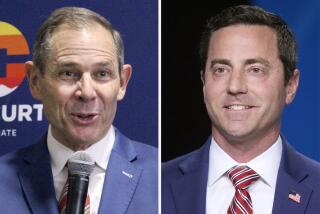Search for Ancestors Leads Many to Utah : Genealogy: Every day, thousands of people seeking their roots pore over the extensive global records in the Mormon Church’s Family History Library.
- Share via
SALT LAKE CITY — For more than a decade Paul Isaacson has labored to save the souls of his dead ancestors, patiently searching miles of microfilm and stacks of catalogues in the Mormon Church’s Family History Library.
Mormon missionary work isn’t limited to the living, and each day thousands of the faithful flock to the library, the world’s largest repository of genealogical records, to fulfill the church’s determination to baptize every person who ever lived.
“There’s something spiritual to it,” said Isaacson, a Mormon who often devotes his days off and evenings to genealogical research. “Also, it’s your roots, your family. It’s kind of like a mystery, trying to track someone down. It’s a puzzle to be solved.”
But as the popularity of tracing one’s roots has grown, the Family History Library of The Church of Jesus Christ of Latter-day Saints has become a prime resource for non-Mormon professional and amateur genealogists.
Of the 3,000 people who use the library each day, about 40% are non-Mormon, said Tom Daniels, the library’s director of information. Often they come by the busload in tours organized by genealogical societies from throughout the United States and Europe.
The most recent survey, conducted in the winter of 1988, indicated that senior citizens made up about 40% of the library’s users--a figure consistent with other surveys of recent years, Daniels said.
Seniors also make up the majority of about 250 church volunteers who supplement the library’s 200 full-time staff members. Daniels said the seniors are “called,” or asked by the church to work at the library for a limited time.
Use of the library is free, and those who come have access to birth and death records of an estimated 1.5 billion to 2 billion people, culled from the archives of about 100 nations.
Business is sufficiently brisk that the church’s genealogical department, which operates the library, has outgrown a three-story building constructed five years ago across the street from the Salt Lake Temple in downtown Salt Lake City.
Several of the department’s divisions are housed in an office building a block away, and the library will expand to occupy a portion of the old Hotel Utah, which is being renovated to house a chapel and administrative offices.
Daniels said library usage has increased 60% since 1984--the greatest period of growth since the early 1970s, when Alex Haley’s book “Roots” turned thousands of people to genealogy as a hobby.
Daniels said he cannot explain the latest surge in genealogical activity. The church has always encouraged its members to research their ancestry and submit names of their forebears to temples, where such ordinances as baptism are performed by living proxies.
But in recent years more people have been taking advantage of the archives, and that may have induced more church members to get involved.
“Why the large number of non-Mormons are coming, I don’t know. Maybe it’s just a natural increase in hobbyists,” he said.
Mormons believe that spirits of dead people should have the opportunity to accept Mormonism in the afterlife. Members are encouraged to have the faith’s ordinances performed for all their ancestors in the hope that they will embrace the faith.
The doctrinal injunction for genealogical work is strong. The church’s founder, Joseph Smith, told his followers more than 100 years ago, “The greatest responsibility in this world that God has lain upon us is to seek after our dead.”
The church has taken Smith’s charge seriously. About 200 photographers are regularly dispatched overseas to photograph records of birth, death and census records in any country that will permit it.
Records have been copied extensively in Europe. More recently the collection effort has shifted to Latin America and Asia.
For eight years church photographers have been copying Chinese records, including some lines that reach back more than 1,000 years.
“They’re far superior, far more accurate, than European records,” Daniels said. “In Oriental records, 65 generations (of continuous record-keeping) are not uncommon. In Europe, you’re lucky to find 10.”
To ensure that nothing is lost, master copies of the microfilm are kept in the church’s Granite Mountain Records Vault, carved deep into a mountainside about 20 miles southeast of Salt Lake City.
Designed to withstand a nuclear explosion, the vault features an archive-quality air filtering system, a complete microfilm processing laboratory and six storage rooms, each 200 feet long and 25 feet high.
Ready to process records as they arrive from overseas is a library staff that collectively is fluent in nearly every major language. On the library floor, staff linguists are available to assist patrons.
“There’s nothing comparable to the library in terms of its comprehensive nature,” said Jay Hall, director of Global Research, a Salt Lake City-based professional genealogical service affiliated with Everton Publishing, which produces a directory of genealogical sources called the Genealogical Helper.
Hall said 98% of his business is with non-Mormons living outside of Utah. Likewise, most of the Genealogical Helper’s 50,000 subscribers are not Mormon and do not live in Utah.
“There’s a vast amount of interest,” Hall said. “A lot of people think it’s totally fascinating to learn about their ancestors. It gives them a feeling of heritage. For the professional, the most important thing is to have the detective feeling.
“It’s kind of like the thrill of the hunt.”
More to Read
Sign up for Essential California
The most important California stories and recommendations in your inbox every morning.
You may occasionally receive promotional content from the Los Angeles Times.










